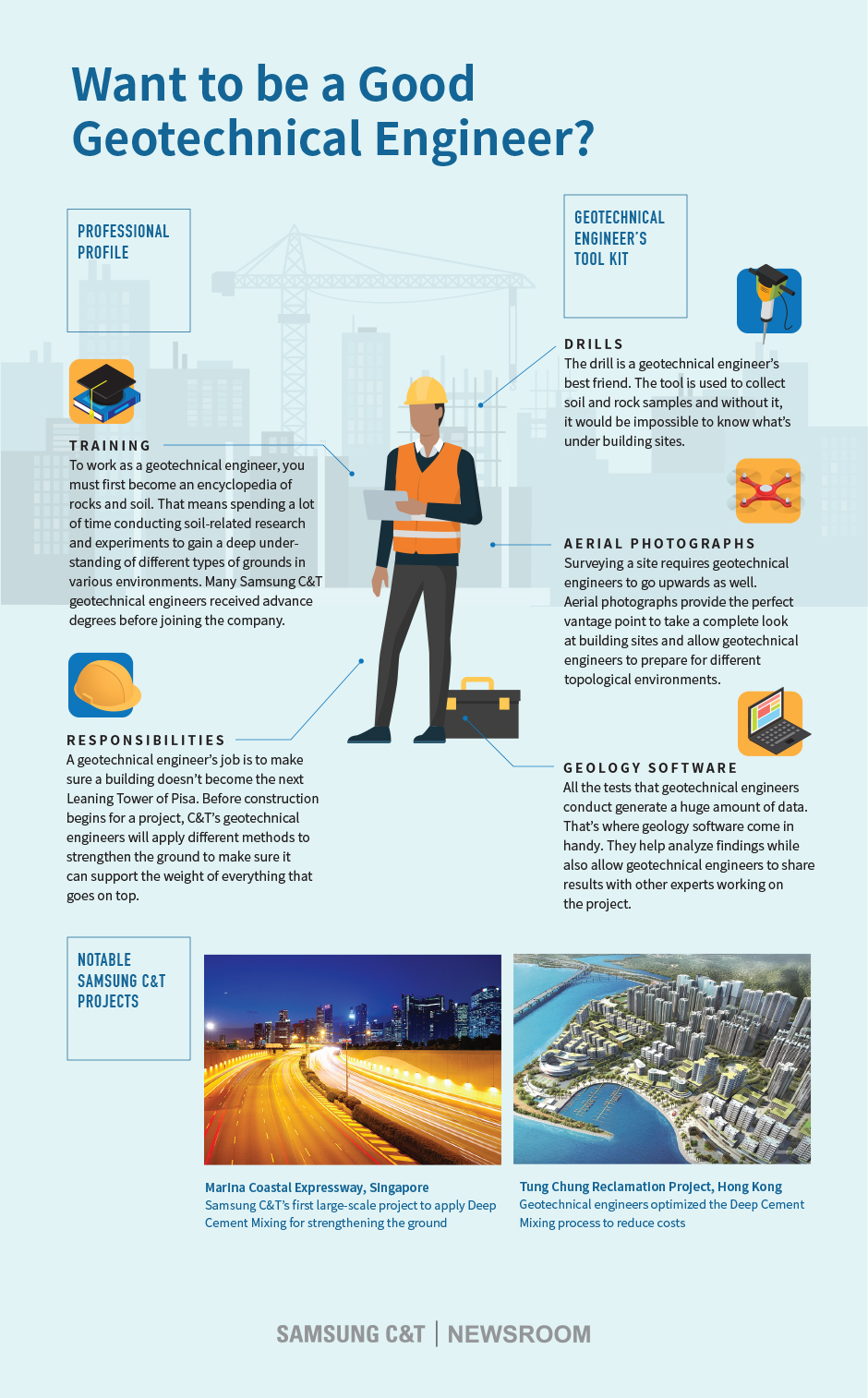Excitement About Geotheta

A geotechnical designer is a specialized civil designer who concentrates on the habits of dirt, rock, and various other materials discovered underneath the Planet's surface. They use scientific principles and engineering techniques to assess the residential or commercial properties and behavior of these materials to sustain the secure and effective design, building, and upkeep of facilities projects.
They perform site examinations, accumulate samples, do research laboratory tests, and evaluate data to review the viability of the ground for construction jobs - Consulting Engineers. Based on their findings, geotechnical engineers provide recommendations for foundation layout, incline security, retaining frameworks, and mitigation of geotechnical hazards. They team up with other specialists, such as architects, structural engineers, and construction groups, to make sure that geotechnical considerations are incorporated right into the general job design and execution
By evaluating the actions and homes of dirt and rock, they can identify prospective geotechnical risks such as landslides, dirt negotiation, or slope instability. Their expertise helps protect against failures or crashes that might threaten lives and residential or commercial property. Below are some in-depth obligations and duties of a geotechnical engineer: Site Investigation: Geotechnical designers conduct site investigations to collect data on subsurface problems.
They analyze the information to recognize the residential or commercial properties and actions of the soil and rock, including their strength, leaks in the structure, compaction qualities, and groundwater problems. Geotechnical Evaluation and Design: Geotechnical designers assess the information accumulated throughout site examinations to evaluate the stability and suitability of the site for building jobs. They carry out geotechnical estimations and modeling to assess elements such as bearing capability, settlement, slope security, lateral earth pressures, and groundwater flow.
The 30-Second Trick For Geotheta
Foundation Layout: Geotechnical designers play a crucial duty in designing structures that can safely sustain the designated structure. They assess the dirt conditions and tons needs to establish the appropriate foundation type, such as shallow structures (e.g., footings), deep structures (e.g (https://www.anyflip.com/homepage/zuylo)., stacks), or specialized methods like dirt improvement. They take into consideration factors such as negotiation limits, bearing capacity, and soil-structure communication to establish optimal foundation layouts
They examine building plans, monitor website activities, and perform field evaluations to verify that the layout referrals are complied with. If unforeseen geotechnical issues arise, they analyze the scenario and provide referrals for remediation or adjustments to the style. Risk Assessment and Reduction: Geotechnical engineers analyze geotechnical risks and threats connected with the project website, such as landslides, liquefaction, or soil disintegration.

Cooperation and Interaction: Geotechnical engineers function carefully with other specialists included in a task, such as architects, architectural designers, and building and construction teams. Efficient interaction and collaboration are necessary to integrate geotechnical factors to consider into the overall task style and construction procedure. Geotechnical engineers supply technological knowledge, solution inquiries, and make certain that geotechnical demands are satisfied.
Facts About Geotheta Revealed
Right here are some kinds of geotechnical engineers: Foundation Designer: Foundation engineers focus on designing and examining structures for frameworks. They analyze the soil conditions, tons needs, and site features to identify one of the most suitable foundation type and style, such as shallow foundations, deep foundations, or specialized techniques like pile foundations.
They review the aspects affecting incline security, such as soil residential or commercial properties, groundwater conditions, and slope geometry, and develop techniques to stop incline failures and reduce dangers. Quake Designer: Earthquake designers concentrate on analyzing and developing structures to hold up against seismic pressures. They examine the seismic threat of a website, examine soil liquefaction potential, and establish seismic style criteria to ensure the safety and strength of structures throughout quakes.
They do area testing, gather samples, and examine the gathered information to identify the dirt properties, geologic developments, and groundwater conditions at a website. Geotechnical Instrumentation Engineer: Geotechnical instrumentation engineers focus on surveillance and gauging the actions of soil, rock, and frameworks. They set up and maintain instrumentation systems that check variables i thought about this such as soil negotiation, groundwater levels, slope movements, and architectural displacements to analyze performance and provide early warnings of prospective issues.
A Biased View of Geotheta
They often tend to be investigative people, which implies they're intellectual, introspective, and inquisitive. They wonder, methodical, rational, logical, and logical. A few of them are also social, implying they're kind, generous, cooperative, individual, caring, useful, compassionate, tactful, and friendly. Does this noise like you? Take our cost-free career test to learn if geotechnical designer is just one of your top occupation suits.
In the workplace setting, geotechnical designers utilize specialized software tools to perform calculations, develop styles, and examine information. They prepare reports, evaluation job requirements, interact with clients and team participants, and coordinate job activities. The office setup supplies a favorable atmosphere for research study, evaluation, and cooperation with other professionals involved in the task.
The Basic Principles Of Geotheta
They often visit job sites to perform website investigations, assess geotechnical conditions, and collect data for analysis. These gos to entail traveling to different locations, in some cases in remote or tough surfaces. Geotechnical designers might carry out dirt sampling, conduct tests, and screen building and construction activities to make certain that the geotechnical elements of the task are being applied correctly.
Geotechnical designers additionally function in specialized geotechnical research laboratories. Geotechnical research laboratory designers function thoroughly in these settings, managing screening devices, operating tools, and recording data.
Comments on “Some Known Incorrect Statements About Geotheta”